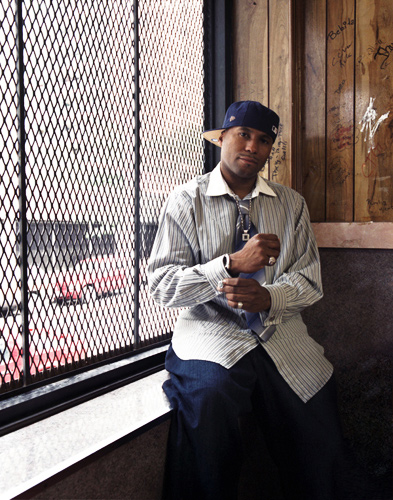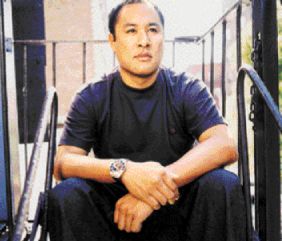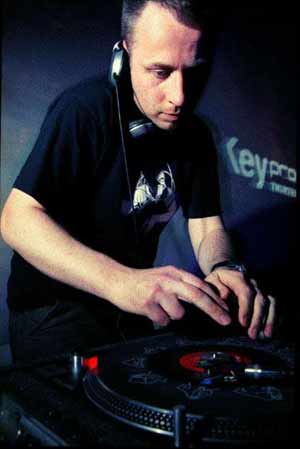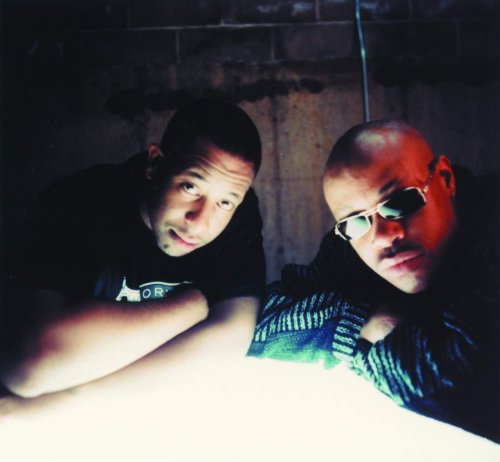GANG STARR / “Check The Technique”
As we’ve discussed previously (check the archives for the week of March 12th, 2006), one of the reasons hip-hop heads love sampling so much is because the process is so malleable. Several DJs or producers could sample the same break from the same record, yet create pieces of music that sound very different. In this post, we’re going to take a look at three records that sample Marlena Shaw’s “California Soul.”
 Let’s start with “A Better Tomorrow” (from Dan The Automator’s 1996 EP A Better Tomorrow), a collaboration between rapper Kool Keith AKA Sinister 6000 and producer Dan “The Automator” Nakamura. I like the way this track begins with over two minutes of the instrumental before Kool Keith comes in. When he finally gets his chance to rhyme, Keith displays his usual (meaning, unusual) style of random word association; most of his one, brief verse is comprised of listing various brands and models of recording equipment.
Let’s start with “A Better Tomorrow” (from Dan The Automator’s 1996 EP A Better Tomorrow), a collaboration between rapper Kool Keith AKA Sinister 6000 and producer Dan “The Automator” Nakamura. I like the way this track begins with over two minutes of the instrumental before Kool Keith comes in. When he finally gets his chance to rhyme, Keith displays his usual (meaning, unusual) style of random word association; most of his one, brief verse is comprised of listing various brands and models of recording equipment.
 In terms of the track, Nakamura is looping a slowed-down version of the drum break from the beginning of “California Soul.” At times, he also seems to be playing around with the drum licks; the main loop sounds like it’s taken straight from the record, but a few times (for example, around the 4:00 mark), Nakamura doubles and triples up the snares, creating a new drum pattern in the process. Strangely enough, another left-field hip-hop producer, DJ Shadow, used this same loop and slowed it down in almost identical fashion for “Midnight In A Perfect World,” a track from his 1999 LP Endtroducing…. I’m not including it here because, as I said, it’s virtually identical to Nakamura’s track.
In terms of the track, Nakamura is looping a slowed-down version of the drum break from the beginning of “California Soul.” At times, he also seems to be playing around with the drum licks; the main loop sounds like it’s taken straight from the record, but a few times (for example, around the 4:00 mark), Nakamura doubles and triples up the snares, creating a new drum pattern in the process. Strangely enough, another left-field hip-hop producer, DJ Shadow, used this same loop and slowed it down in almost identical fashion for “Midnight In A Perfect World,” a track from his 1999 LP Endtroducing…. I’m not including it here because, as I said, it’s virtually identical to Nakamura’s track.
 I don’t know much about DJ Food except that, despite the name, they’re a ‘they’ not a ‘he.’ I also know they’re on Ninja Tunes, a label that’s known for attempting to bridge the considerable gap between jazz and electronica. I don’t hear much jazz in “Dark Lady” (from Funkjazztical Tricknology
I don’t know much about DJ Food except that, despite the name, they’re a ‘they’ not a ‘he.’ I also know they’re on Ninja Tunes, a label that’s known for attempting to bridge the considerable gap between jazz and electronica. I don’t hear much jazz in “Dark Lady” (from Funkjazztical Tricknology, reissued in 2003) but I do hear the electronica. More to the point, I also hear the sample of “California Soul.” What’s different about this sample is the way the Food crew emphasizes the hand claps. When I first heard “Dark Lady,” I hadn’t noticed that the hand claps are there in “California Soul.” They are, and of course, DJ Food couldn’t resist looping the drum break as well. “Dark Lady” is neither a great song nor particularly distinctive, but since adding it to my electronica playlist a few weeks ago, I enjoy hearing it every time it comes on.
 Unlike DJ Food, I do know a lot about Keith ‘Guru’ Elam and Christopher ‘Premier’ Martin, BKA Gang Starr. The combination of Premier’s unique production work and Guru’s calm, yet menacing vocal style have made the now-defunct Gang Starr duo members of hip-hop’s royalty. “Check The Technique” is a track from Gang Starr’s second album, 1991’s Step In The Arena. That album is arguably their finest moment—although I prefer 1992’s Daily Operation, but that’s just me—and it’s packed full of Premier’s tightly-constructed, sample-heavy production work. Nowadays, thanks to sites like The-breaks.com, everyone knows (or can know) the source of all the magical sounds that come bursting forth from all those Gang Starr classics. Back in the early Nineties though, the average fan had no idea what was a sample and what wasn’t. All we knew was Premier’s productions had a certain something others didn’t. Just one example of what separates Premier from so many other like-minded but lesser artists: for live performances, he presses separate dub plates of his beats and samples so that he can recreate his mixes live on stage. Compare that with just running a DAT machine while standing behind the turntables pretending to deejay.
Premier’s best work depends on his encyclopedic knowledge of recorded music and his legendary vinyl collection (it numbers in the tens of thousands) as much as it depends on his actual skill as a DJ. To my knowledge, Premier was the first producer to use the “California Soul” break; and, he made the best use of it. By looping the drum break, Premier extended that great funk moment from one bar to the length of the entire song. Since he did it, others have followed suit, but Premier is still the only producer who figured out a way to use the strings as well. By doing so, he recreated the euphoric feel of the original. In all fairness, nowadays producers can’t get away with using the types of loops Premier favored in his early productions. Sampling is big business. A record like “Check The Technique” would be so expensive to release today that it would probably never get cleared. Still, even when you compare Premier to his contemporaries, there’s something about his work that stands out. For me, Premier is living proof that sampling is as much an art-form as is singing, rapping or playing an instrument.
—Mtume ya Salaam
It Ain’t What I Think
Mtume, man, am I glad you broke this down, otherwise, I swear, my finger would have stayed on the skip button. Kool Keith is sicque, tres sicque. I've heard accidents in the canned food aisle sound hipper than this. But what do I know? The DJ Food track is only marginally more listenable, perhaps because there is a greater use of melodic elements. Now the Gang Starr, I’m down with that all the way. You are absolutely right about DJ Premier, plus I’ve always liked Guru’s sound, the timbre of his voice.
I listened to these tracks long before I read your write-up and I wasn’t feeling them at all in the Marlena Shaw context, but what your insights do is cause me to pause. I hit rewind and with your roadmap in mind, I check out aspects of these tracks that I completely missed when I listened without understanding, which all goes to prove that no matter how much we know (or think we know), there’s a lot of stuff we don’t know.
There’s no ignoramus as large as someone who considered themselves highly educated. Seems like the more we know, the more we think we know, when, truth be told, there is no correlation between how much we know and how much we don’t know.
All three of these tracks are based on Marlena Shaw. I never would have knowed it if Mtume hadn’t showed it. Sherlock Holmes strikes again.
—Kalamu ya Salaam
Unlike DJ Food, I do know a lot about Keith ‘Guru’ Elam and Christopher ‘Premier’ Martin, BKA Gang Starr. The combination of Premier’s unique production work and Guru’s calm, yet menacing vocal style have made the now-defunct Gang Starr duo members of hip-hop’s royalty. “Check The Technique” is a track from Gang Starr’s second album, 1991’s Step In The Arena. That album is arguably their finest moment—although I prefer 1992’s Daily Operation, but that’s just me—and it’s packed full of Premier’s tightly-constructed, sample-heavy production work. Nowadays, thanks to sites like The-breaks.com, everyone knows (or can know) the source of all the magical sounds that come bursting forth from all those Gang Starr classics. Back in the early Nineties though, the average fan had no idea what was a sample and what wasn’t. All we knew was Premier’s productions had a certain something others didn’t. Just one example of what separates Premier from so many other like-minded but lesser artists: for live performances, he presses separate dub plates of his beats and samples so that he can recreate his mixes live on stage. Compare that with just running a DAT machine while standing behind the turntables pretending to deejay.
Premier’s best work depends on his encyclopedic knowledge of recorded music and his legendary vinyl collection (it numbers in the tens of thousands) as much as it depends on his actual skill as a DJ. To my knowledge, Premier was the first producer to use the “California Soul” break; and, he made the best use of it. By looping the drum break, Premier extended that great funk moment from one bar to the length of the entire song. Since he did it, others have followed suit, but Premier is still the only producer who figured out a way to use the strings as well. By doing so, he recreated the euphoric feel of the original. In all fairness, nowadays producers can’t get away with using the types of loops Premier favored in his early productions. Sampling is big business. A record like “Check The Technique” would be so expensive to release today that it would probably never get cleared. Still, even when you compare Premier to his contemporaries, there’s something about his work that stands out. For me, Premier is living proof that sampling is as much an art-form as is singing, rapping or playing an instrument.
—Mtume ya Salaam
It Ain’t What I Think
Mtume, man, am I glad you broke this down, otherwise, I swear, my finger would have stayed on the skip button. Kool Keith is sicque, tres sicque. I've heard accidents in the canned food aisle sound hipper than this. But what do I know? The DJ Food track is only marginally more listenable, perhaps because there is a greater use of melodic elements. Now the Gang Starr, I’m down with that all the way. You are absolutely right about DJ Premier, plus I’ve always liked Guru’s sound, the timbre of his voice.
I listened to these tracks long before I read your write-up and I wasn’t feeling them at all in the Marlena Shaw context, but what your insights do is cause me to pause. I hit rewind and with your roadmap in mind, I check out aspects of these tracks that I completely missed when I listened without understanding, which all goes to prove that no matter how much we know (or think we know), there’s a lot of stuff we don’t know.
There’s no ignoramus as large as someone who considered themselves highly educated. Seems like the more we know, the more we think we know, when, truth be told, there is no correlation between how much we know and how much we don’t know.
All three of these tracks are based on Marlena Shaw. I never would have knowed it if Mtume hadn’t showed it. Sherlock Holmes strikes again.
—Kalamu ya Salaam
This entry was posted on Sunday, June 4th, 2006 at 12:09 am and is filed under Contemporary. You can follow any responses to this entry through the RSS 2.0 feed. You can leave a response, or trackback from your own site.
5 Responses to “GANG STARR / “Check The Technique””
June 4th, 2006 at 11:47 am
“You puny protozoa?”
Guru was at his intellectual best on the “Step in The Arena” album.
Premier, the Prairie View alumnus, showed his ass on the beats. This is clearly Gang Starr’s greatest creation.
only
Ice Cube’s “AmeriKKKa’s Most..”
Brand Nubian’s “One For All”
LL’s “Mama Said..”
and BDP’s “Edutainment”
had albums in the same class that year (90).
“Dwick,” “Take It Personal,” and “I’m The Man,” notwithstanding,
DAILY OPERATION, albeit a damn good album, had too much gun play for my taste.
Guru sort of dumbed down to his audience.
Mtume, nitpicking aside, we knew what sampling was during the 20 century’s last
decade. Once Marley Marl "really" imposed his will on hip hop from 87 on, we were
clear.
In fact, the following year Biz Markie got sued out the wazoo by some old white dude
for “sampling” his tunes without authorization. The public and purists would forever
be educated.
Mtume says:
Nadir, slow down, man. Let me try to take this in order. First, if you’re making a ‘Great Rap Albums of 1990’ list, it has to be longer than that. 1990 was a banner year for the music. I can’t knock any of your selections, but what about PE’s Fear Of A Black Planet and ATCQ’s People’s Instinctive Travels? And what about the Beastie Boys’ Paul’s Boutique? Still one of my favorite hip-hop LPs ever and certainly the best ever dropped by any of our melanin-challenged brethren.
Second, you’re going to boil down the Daily Operation album to three tracks? Some of Gang Starr’s best-ever material is on there: "Ex Girl To The Next Girl," "Soliloquy Of Chaos," "2 Deep," "No Shame In My Game," "Conspiracy." Damn, I could just put the whole track listing on here. There’s not a bad track on the LP. Not to mention that "Dwyck" isn’t on the Daily Operation album anyway. It was a b-side (don’t remember to which single) and later they added it to Hard To Earn as a bonus for people who didn’t buy 12"s. So essentially, you’re telling us that Daily Operation had two good songs on it? That’s silly. And, you’re talking about too much gunplay? "Soliloquy Of Chaos" is telling cats to chill with the gunplay so the hip-hop show can go on. "Conspiracy" is in a similar vein, lyrically. You need to pull out Daily Operation and listen again.
And last, I didn’t say we didn’t know what sampling was back then. (I can see how you thought that’s what I meant though. I could’ve phrased it better.) What I actually said was: "Back in the early Nineties though, the average fan had no idea what was a sample and what wasn’t." Meaning, you couldn’t tell when a DJ was looping something and when he wasn’t. We knew what loops were, we just couldn’t I.D. them all that easily. Nowadays, when I hear a sample, I just click over to one of the sample I.D. sites and, bam, there it is. Back then, I always had to wonder.
June 4th, 2006 at 11:48 am
An awesome roundup this week, guys. I always wondered where the Shadow/Midnight drums came from.
For the other driving Dark Lady sample, check out the lead track on Floria Purim’s ‘Open Your Eyes You Can Fly’.
June 4th, 2006 at 1:09 pm
OK, I just did a little checking to confirm the "Dwyck" situation. Here’s the deal (from sandbox.com):
The first 12" off the new LP [meaning, Daily Operation] literally blew fans away. "Take It Personal" was a much darker track than most were used to but it featured some ill ass lyrics from Mr. Guru. But in all honesty, it was "DWYCK" that was blowing this 12" up all over the country. Featuring a rediculous head-knoddin bounce track and a great cameo from Nice & Smooth, this was to be a much sought after 12" after those idiots at Chrysalis left "DWYCK" off the album…
BTW, I always assumed D.W.Y.C.K. was an acroynm for something. Anybody know for what?
June 4th, 2006 at 1:30 pm
“Welcome to the Terrordome”—si.
“Fear Of A Black Planet”—uuuhhh.
I missed Hank Shocklee.
Had a brain fart on Tribes first album,
a classic indeed.
As for your Daily Operation argument, I can’t hate on your reasoning.
I still prefer “Step” though.
Sorry about the “Dwick” reference, should’ve looked at the collection before I spoke.
“Paul’s Boutique” came out in 89, so I guess we’re even with the oops.
The Beastie’s classic second album single handedly changed the way producers used samples.
I pump that shit like deflated tires.
Mtume says:
Beastie Boys’ Paul’s Boutique. Original release date: July 31, 1989. 
June 4th, 2006 at 4:26 pm
There’s other good ones, of course, but I think the other essential album from 1990 is Kool G Rap & Polo’s 2nd, and best, _Wanted Dead or Alive_.
I don’t think “DWYCK” stood for anything, but I don’t remember what it’s supposed to mean (if anything).
Leave a Reply
| top |